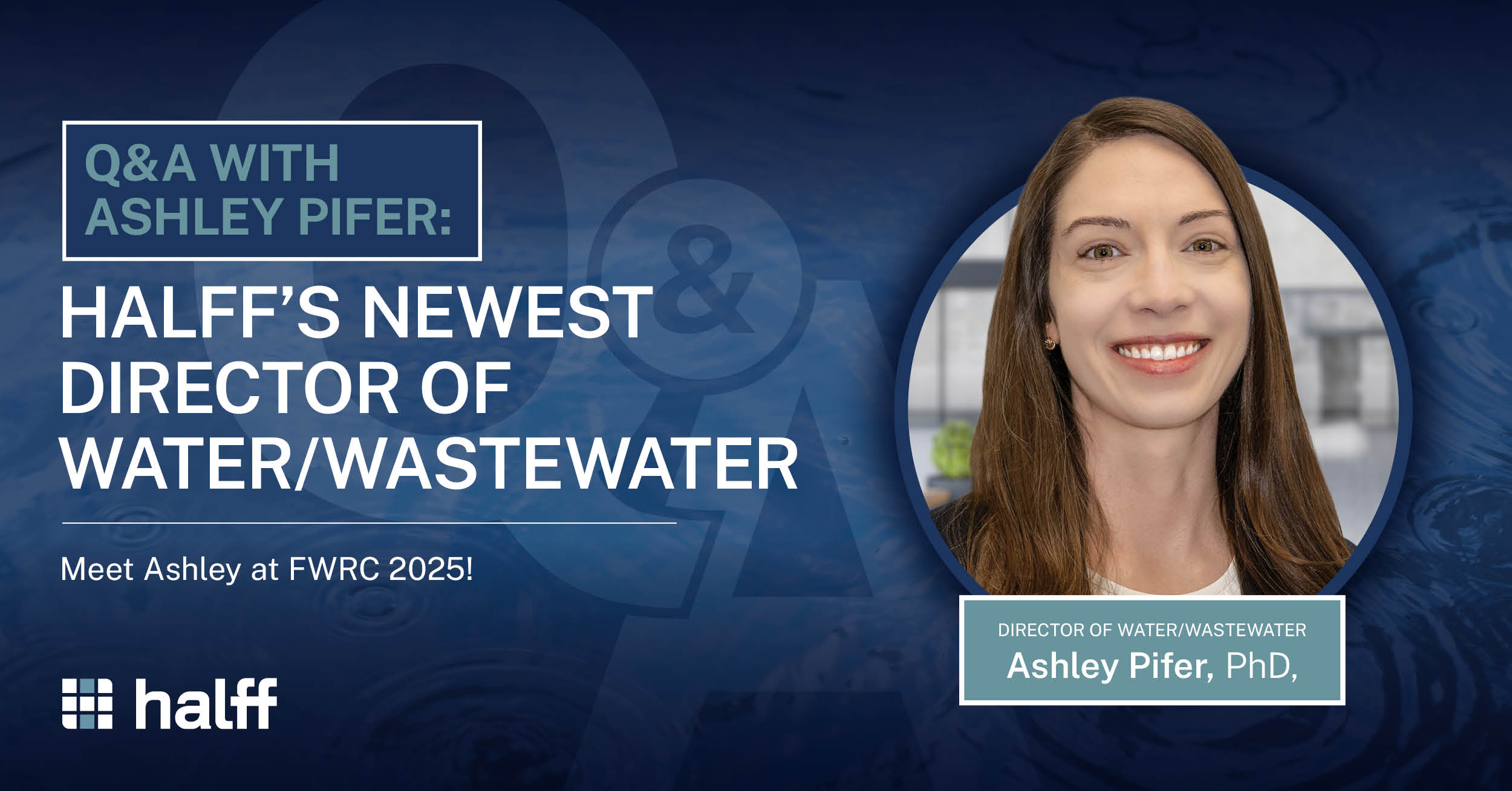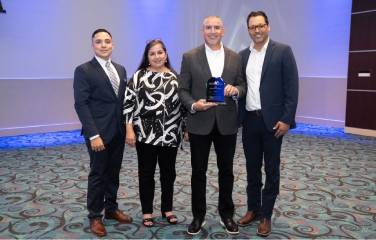Q&A With Ashley Pifer: Halff’s Newest Director of Water/Wastewater
Ashley Pifer is a nationally recognized water quality expert who recently joined Halff’s Fayetteville office. Specializing in disinfection and distribution system water quality, she has years of experience conducting applied research, treatment process feasibility studies, water quality assessments, and detailed designs for water and wastewater utilities nationwide.
We’re excited to sit down with Ashley as she shares her extensive knowledge and how Halff is providing innovative solutions to Florida’s water quality challenges.
Let’s dive into the conversation!
My interest in water/wastewater began when I was an undergraduate at the University of Arkansas and a professor asked me to participate in a student presentation competition at the state water conference. He suggested I cover one of his consulting projects — a pilot study for a membrane bioreactor system for a local wastewater treatment plant — in the presentation. Between the topic and the welcoming environment at the conference, I was hooked.
After graduating with a Bachelor of Science in Civil Engineering, I began working on my PhD, focusing my research on disinfection byproduct precursor characterization and removal through conventional and novel treatment processes.
After I finished my PhD, I began working at a regional firm as a process engineer on a range of water and wastewater treatment projects. For example, I have designed disinfection systems for water and wastewater treatment plants from less than 1 to 125 MGD in size, filtration systems, and even solids thickening and cake storage upstream of a thermal hydrolysis system. I have also served as the technical lead for a pilot study that evaluated pellet softening upstream of ultrafiltration membranes for a water utility that needed to bring a challenging back-up water supply into use.
Over time, I have specialized in disinfection and distribution system water quality. My initial distribution system water quality work focused on disinfection byproduct control for free chlorine systems, and nitrification management for chloraminated systems, including developing fluorescence sensor systems for early detection of nitrification as part of a Water Research Foundation tailored collaboration. Recently, I have helped water systems from Texas to North Carolina develop service line inventories and overall compliance strategies as the Lead and Copper Rule Revisions (LCRR) and LCR Improvements (LCRI) have been introduced.
Florida primarily relies on groundwater as the drinking water supply, and water quality issues vary by location. Areas pulling from the Upper Floridan aquifer have good quality groundwater, only requiring disinfection or perhaps aeration and pH adjustment to remove hydrogen sulfide. However, in areas using the Lower Floridan aquifer, the groundwater may have higher concentrations of iron, and in some cases manganese, requiring oxidation and filtration. Some of the water has hardness and high total organic carbon, requiring softening and careful attention to disinfection byproduct formation, respectively.
Saltwater intrusion is a significant concern in coastal areas, particularly as the population increases and drives demand on freshwater aquifers. Saltwater intrusion increases the salinity of the water, and membrane-based desalination may be necessary to continue producing potable water. In some areas, reclaimed water is injected into the aquifers to alleviate the effects of saltwater intrusion.
Many Florida communities will also have to address per- and polyfluoroalkyl substances (PFAS). The EPA’s Unregulated Contaminants Monitoring Rule (UCMR) 5 requires water systems serving more than 3,300 people to monitor for PFAS between 2023 and 2025. To date, 152 large and 98 small water systems in Florida have completed the monitoring, and 38% and 27%, respectively, have average PFAS concentrations above at least one of the new PFAS maximum contaminant levels.
The drinking water regulatory space has been extremely active in the last few years. USEPA has finalized three significant new regulations, and efforts are ongoing to revise five additional regulations.
First, USEPA released the LCRR, with the compliance date in 2024, which just passed. Now, utilities need to prepare for the LCRI, which has a compliance date in late 2027. They will need to update their service line inventories and develop a service line replacement plan by the LCRI compliance date. Service lines classified as lead or galvanized requiring replacement will need to be replaced by the end of 2037. Additionally, utilities will need to update their sampling programs. They may also need to install or optimize corrosion control treatment if lead in tap samples exceeds 10 micrograms per liter, the new lead action level under the LCRI.
USEPA also finalized regulations for six PFAS in drinking water in 2024. The new regulation requires water systems to conduct initial monitoring for PFAS at entry points to their distribution systems by early 2027, and install treatment (if needed) to comply with maximum contaminant levels by early 2029. Water utilities should prioritize completing initial monitoring or review data collected as part of the UCMR 5. If PFAS are present, they will need to determine if there are opportunities to control PFAS concentrations through blending or source protection, or if PFAS treatment will be needed.
USEPA is also expected to release proposed revisions to the Microbial and Disinfection Byproducts (MDBP) Rules this summer. The MDBP Rule revisions are likely to include provisions to decrease risk from opportunistic pathogens, such as Legionella, and potentially modify treatment requirements to increase removal of the organic materials in water that react with disinfectants to form disinfection byproducts.
Florida communities should continue monitoring regulatory activity at the federal level, as well as watching for the release of state-specific guidance from the Florida Department of Environmental Protection.
Our Water/Wastewater team is dedicated to planning and designing water and wastewater treatment facilities, distribution networks, and collection systems for communities across Florida. We stay involved throughout the construction process, whether using traditional design-bid-build methods or innovative alternative project delivery approaches. Our experienced team members, including Rob Ern, Randy Coslow, Mike Scullion and Bill Dorman, are experts in process optimization and troubleshooting. Our team helps utilities achieve excellent water quality and energy efficiency, while maximizing their operating budgets.
As regulations and technologies evolve and populations grow, Halff supports utilities as they prepare for and manage change. We work with water systems to determine the actions they need to take to comply with new regulations, including feasibility studies and treatment process bench- and pilot-scale testing. We also provide master planning, capital improvements program development and rate studies. Our team also provides funding assistance throughout the life of a project, from identifying and applying for grants and loans to support projects, to environmental assessments, to grant/loan administration. Halff helps utilities track the location and condition of assets using GIS. We also develop predictive models for condition assessments and, more recently, classifying service line materials for regulatory compliance.
If you’re attending the Florida Water Resources Conference in West Palm Beach, Florida on May 4-7, be sure to stop by and connect with Ashley and Halff’s Water/Wastewater team to learn more about how we’re improving water quality and helping Florida communities thrive.
We look forward to seeing you there!



